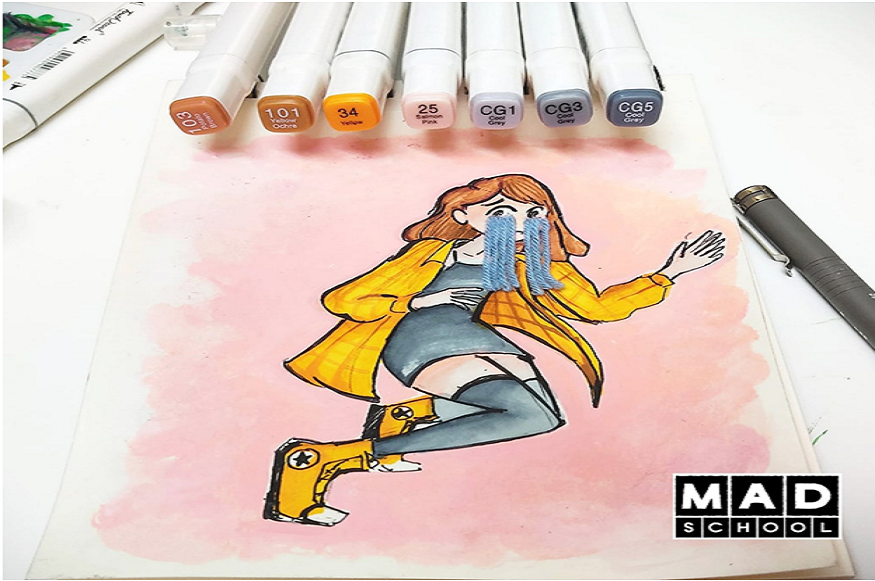
How to Build a Powerful Portfolio for Top Design Colleges & Creative Careers
A design portfolio is more than just a collection of artworks—it’s a visual identity that showcases your creativity, skills, and ability to think conceptually. Whether you are applying for NID, NIFT, UCEED, CEED, JEE Paper 2 (B.Arch) or aiming for top international design universities, a well-crafted portfolio can set you apart from the competition.
What is a Design Portfolio?
A portfolio is a curated compilation of an artist’s or designer’s work, intended to reflect their unique style, methodology, and creative thought process. It serves as a storytelling tool, presenting a clear narrative of your journey, inspirations, and expertise in various aspects of design, including:
- Sketching & Illustration
- Graphic Design & Digital Art
- Product & Industrial Design Concepts
- Fashion & Textile Design
- Architecture & Interior Design
- Animation, Storyboarding & Photography
Whether applying for design schools, creative jobs, or freelance projects, a strong portfolio is your best foot forward.
Why is a Portfolio Important?
Top design institutes and companies consider a portfolio a “De Facto” requirement for selection. It demonstrates:
- Your creative thinking & problem-solving skills
- Your technical expertise in a chosen medium
- Your ability to experiment & innovate
- Your storytelling & presentation skills
Many design entrance exams also require a portfolio as part of their admission process. Some of these include:
- NID Entrance Exam (National Institute of Design)
- NIFT Situation Test (National Institute of Fashion Technology)
- UCEED (Undergraduate Common Entrance Exam for Design)
- CEED (Common Entrance Exam for Design – PG level)
- JEE Paper 2 (B.Arch)
Apart from national institutes, many international design universities require portfolios, each with unique guidelines.
How to Structure Your Portfolio?
Creating a well-structured portfolio is essential to showcase your creative skills effectively. Your portfolio should tell a story about your journey as a designer or artist, highlighting your unique approach and thought process. Follow these steps to build a compelling portfolio:
1. Keep It Minimal Yet Impactful
Your portfolio should be 10-25 pages long and contain only your best work. Avoid unnecessary clutter—quality matters more than quantity. Each page should have a clear purpose, guiding the viewer smoothly from one section to the next.
2. Include a Strong Introduction
Begin with a cover page that includes your name, area of expertise, and a simple yet impactful design. Follow this with:
- A bio: A short introduction about yourself, your background, and what inspires you.
- Creative statement: A brief paragraph describing your artistic vision, philosophy, and what makes your work unique.
- Table of contents: If your portfolio is lengthy, include a list of sections for easy navigation.
3. Showcase a Variety of Work
Your portfolio should reflect your range of skills. It’s best to include different types of work, such as:
- Observational sketches: Freehand drawings showcasing your ability to replicate real-life objects and environments.
- Digital artwork: Any work created using design software like Adobe Photoshop, Illustrator, or Procreate.
- Conceptual work: Projects that demonstrate your thought process, such as branding, product design, or UI/UX work.
- Abstract art and personal projects: If applicable, add pieces that reflect your experimental or artistic explorations.
4. Highlight Your Creative Process
Design schools and employers love to see how you think. Your portfolio should include a process section that details how you approach projects:
- Research and brainstorming: Show mood boards, mind maps, or written ideas.
- Rough sketches and ideation: Display thumbnails and drafts to illustrate your problem-solving process.
- Final execution: Present your refined, high-quality final designs, paintings, or projects.
- Reflections: A short write-up on what you learned, challenges faced, and how you improved.
5. Organize Your Portfolio Logically
The order in which you present your work is crucial.
● Start with strong, eye-catching projects to make a great first impression.
● Arrange work from simple to complex to show growth and progression.
● End with another standout project to leave a lasting impression.
6. Choose the Right Format
Depending on the purpose, your portfolio can be:
- A digital PDF (best for university applications and job submissions).
- An online portfolio hosted on platforms like Behance, Dribbble, or Wix for wider accessibility.
- A printed portfolio (especially for interviews or in-person presentations).
7. Add Testimonials and References
Including letters of recommendation from teachers, mentors, or industry professionals can strengthen your portfolio. Client testimonials (if applicable) also add credibility.
8. Keep It Updated
Your portfolio is a living document—regularly update it with new projects and remove outdated work to keep it relevant.
Popular International Design Schools That Require Portfolios
If you are applying to top-ranked international design colleges, a portfolio is often mandatory. Here are some prestigious institutions that assess portfolios for admission:
United Kingdom & Europe
- Royal College of Art (RCA), UK
- Polimoda, Italy
- Istituto Marangoni, Italy/Paris/London
- Domus Academy, Italy
- NABA (Nuova Accademia di Belle Arti), Italy
- Glasgow School of Art, UK
- University of Edinburgh, UK
United States & Canada
- Parsons School of Design, New York
- Rhode Island School of Design (RISD)
- Pratt Institute, New York
- Savannah College of Art and Design (SCAD)
- Fashion Institute of Technology (FIT), New York
- Sheridan College, Canada
Asia & Australia
- RMIT University, Australia
- Hong Kong Design Institute (HKDI)
- LASALLE College of the Arts, Singapore
- Nanyang Academy of Fine Arts (NAFA), Singapore
Design Entrance Exams That Require a Portfolio
Some design entrance exams also require a portfolio as part of their selection process. These include:
🔹 NID Entrance Exam (National Institute of Design, India)
🔹 NIFT Situation Test (National Institute of Fashion Technology, India)
🔹 UCA (University for the Creative Arts, UK)
🔹 CEED (Common Entrance Exam for Design, India) – IIT M.Des programs
🔹 Pearson BTEC Art & Design Qualifications
How Mad School Can Help You Build a Winning Portfolio
At Mad School, we specialize in Portfolio Preparation Classes for students aiming for top design colleges in India and abroad. With 13+ years of expertise, we offer:
- Expert guidance tailored to meet university standards and requirements
- Hands-on training with creative workshops
- Techniques to organize & present work effectively
- Personalized feedback to refine your portfolio
- Mock interviews & presentation skills training
If you are serious about building a standout portfolio, join our hands-on Portfolio Preparation classes in Hyderabad & Chennai!
Conclusion
A well-prepared portfolio is the stepping stone to your dream design career. Whether you’re applying for NID, NIFT, UCEED, CEED, JEE Paper 2, or international design universities, a portfolio that tells a compelling story can make all the difference.
Need guidance? Mad School is here to help! Get in touch with us to kickstart your portfolio preparation journey.
📍 Mad School – Hyderabad & Chennai
📞 Call: +91 9959750006
🌐 Website: www.madschool.in, https://www.madschool.in/chennai
📩 Email: [email protected]


